Story and visual influences on The X-Files : Season 7
– Season 7 [1999-2000] –
7X03: The Sixth Extinction
– Chariots of the Gods? (Erich Von Däniken, 1968)
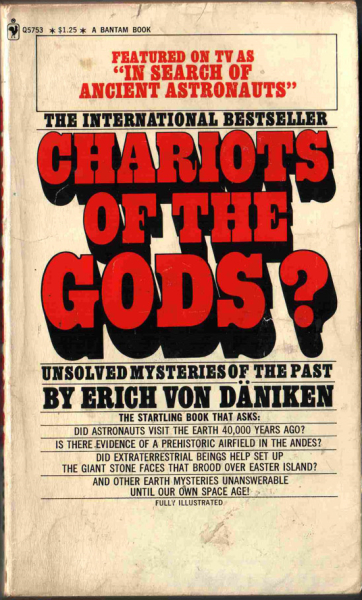
The real title of this book is Memories of the Future: Unsolved Mysteries of the Past, however its tagline “Chariots of the Gods?” prevailed and this is how it is known. This is of course a founding book of the whole “ancient astronauts” or “ancient aliens” theories: Von Däniken did not invent the idea but he certainly immensely popularized it starting with this book and became identified with these ideas for a good two decades — instigating people who were using more sound scientific methods, like Carl Sagan (e.g. chapter in The Cosmic Connection, 1973), to write rebuttals.
In particular, the investigation of ancient artifacts, hieroglyphs, ancient texts (including the Bible), or the location of ancient monuments and their interpretation as evidence of contact with extraterrestrial visitors originate with this book, including the idea that ancient religions originate from contact with aliens.
– Quatermass and the Pit (Nigel Kneale, 1958-1959)
“Alien archaeology” and the alien origins of mankind might be tropes that are now widely known in popular culture, however perhaps the first foray of this idea in mass media was with this BBC mini-series. “Quatermass and the Pit” is the third Quatermass mini-series (see 1X08: Space, 3X02: The Blessing Way and 8X08: Per Manum for other instances of Quatermass influences on the X-Files) and deals with the discovery of an alien ship during an archaeological dig in London, and the way it influences people who come into contact with it. Similarities go way beyond that: the “Quatermass” ancient aliens turn out to have been a dying race who genetically modified certain humans in order to give them some of their alien abilities (psychic powers, telepathy) — in effect, a small percentage of the human population is descending from the aliens — and the buried ship was one of the “seed” ships of this new breed of humans. It was re-made by Hammer Films (in color) a few years later.
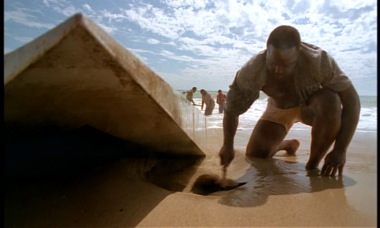 |
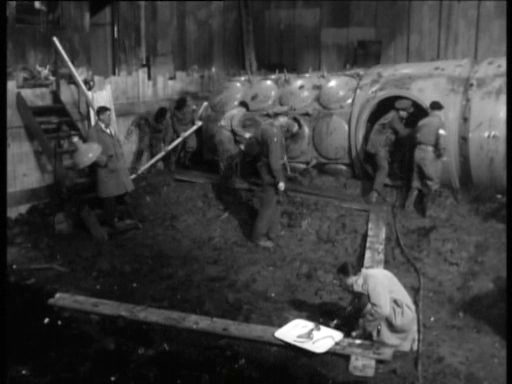 |
7X03: The Sixth Extinction II: Amor Fati
– The Last Temptation (Nikos Kazantzakis, 1953)
Thanks to the story input by David Duchovny, the entire episode is essentially an X-Files adaptation of this novel by the excellent Greek writer Kazantzakis. The novel puts the weight on the “Man” in the Man/God nature of Jesus Christ and describes Jesus’ doubt and fears over the task that he has been sent to accomplish. The novel then narrates what would have happened had Jesus not died on the cross: mary Mary Magdalene, move in a house and lead a “normal” life, be a bystander as Paul announces a new religion, grow old, and ultimately be accused by his ex-Apostles of betrayal and desertion. This all turns out to be a dream ushered on him by Satan in the form of an angel, and Jesus awakens to die on the cross. The similarities with the episode are too many to list: Mulder/Jesus, CSM/Satan, Scully/Apostles, Fowley/Mary… The novel was adapted as a movie by Martin Scorcese in 1988.
– The Invaders S1#10: The Innocent (Norman Klenman, Bernard Rothman, John W. Bloch; created by Larry Cohen, 1967)
While “The Last Temptation” is the most obvious inspiration (especially considering Duchovny’s injections of literary references in his script contributions) and was the one most spotted by the media as well, this episode is also a possibility. See the Pilot for the inspiration from this show’s David Vincent (Roy Thinnes) for the character of Mulder.
In this episode, David Vincent is abducted by the Invader aliens and he is made to live in a dream world, where the work of the Invaders is shown to be beneficial for mankind; however David Vincent realizes the trick and wakes up from the dream.
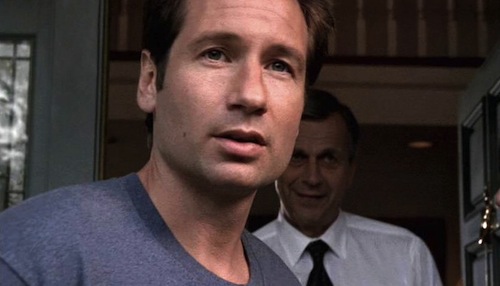 |
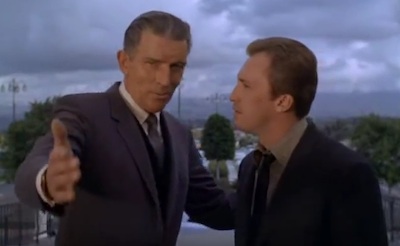 |
 |
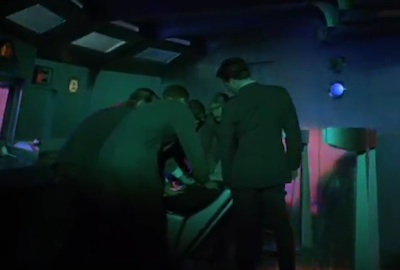 |
The whole extended scene has a feel of being “tempted by the devil”, similar to the dream world presented to Mulder by the CSM. It is too good to be true: David Vincent meets a good friend of his, and reunites with a lost love of his — in the same way Mulder sees Samantha again. When he wakes up he is strapped lying on an operation chair, surrounded by aliens — a bit like how we switch from dream to reality in the episode, where Mulder is undergoing the brain operation.
The entire act-long sequence can be seen on YouTube. Reference spotted by Chris Knowles of The Secret Sun.
– Hamlet (Shakespeare, ca. 1599)
Albert Hosteen’s line to Scully “There are more worlds than the one you can hold in your hand.” is reminiscent of the following:
Act I, scene v:
“There are more things in heaven and earth, Horatio,
Than are dreamt of in your philosophy.“
(Also quoted in Twin Peaks!)
7X01: Hungry
– Columbo (created by William Link and Richard Levinson, 1968-2003)
In this interview, Vince Gilligan says: “Originally, I wanted to do a story about a monster from the monster’s point of view, sort of like an episode of Columbo where you were following the bad guy throughout the show and then Columbo, or in this case Mulder, keeps coming in and asking questions that make it clear that he suspects our main guy.”
Columbo is of course the well-known detective portrayed by Peter Falk in the long-running series, in which the episodes were “reversed”, ie we follow the events from the perpetrator’s point of view and see how Columbo eventually manages to understand he is the killer and catch him.
7X05: Millennium
– Night of the Living Dead (George A. Romero, 1968)
The zombie actually originates from Haitian folklore: a corpse resurrected by witchcraft. The zombie as it is most often found in horror/splatter films however, the “living dead” flesh-eating mindless cannibal with a half-decomposed body and that moves in hordes, is different from that of the Haitian legend and largely originates from the seminal black-and-white horror film “Night of the Living Dead”, which inspired countless successors (“Evil Dead”, “Buffy the Vampire Slayer”, “28 Days Later”, “The Walking Dead”, just to name a few…). The X-Files’ previous foray into zombies, 2X15: Fresh Bones, dealt with the Haitian zombie; this episode borrows from the Romero zombie.
 |
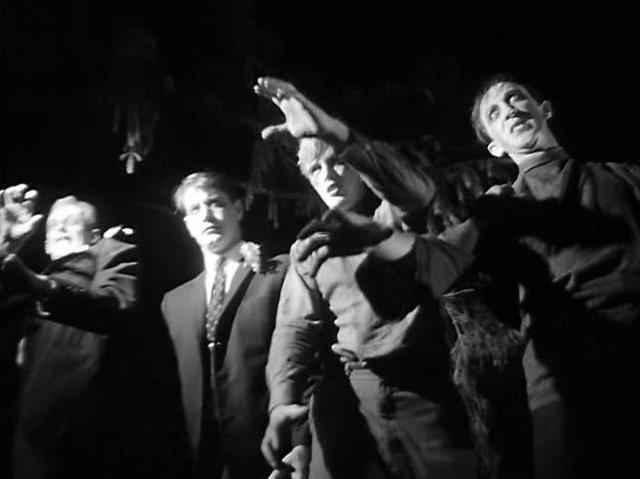 |
7X06: Rush
– The Matrix (The Wachowski Brothers, 1999)
In the spring/summer of 1999, “The Matrix” became a sleeper hit, and suddenly cyberpunk was cool. One of the trademark effects of this movie was “bullet time”: time is slowed down and the camera moves around the scene, being able to follow the trajectory of a bullet, the effect showing the heightened perception of the main character Neo (Keanu Reeves). In the episode, there is not quite the same special effect, however the story does end up showing hyperkinetic teenagers moving around faster than bullets, complete with aerodynamic effects on the trajectory of the bullet.
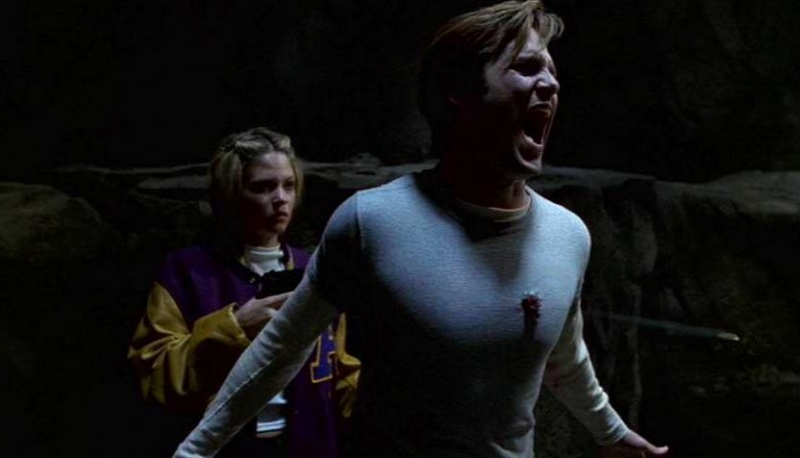 |
 |
7X13: First Person Shooter
– Basic Instinct (Paul Verhoeven, 1992)
The way Jade Blue Afterglow (Krista Allen) uncrosses and re-crosses her legs in this episode, complete with the frontal camera angle, is a direct reference to a famous shot of “Basic Instinct”, where Sharon Stone does the same.
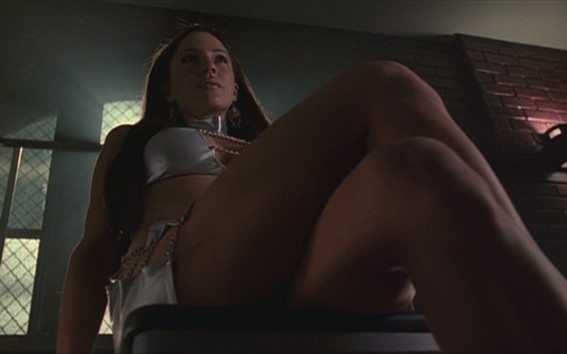 |
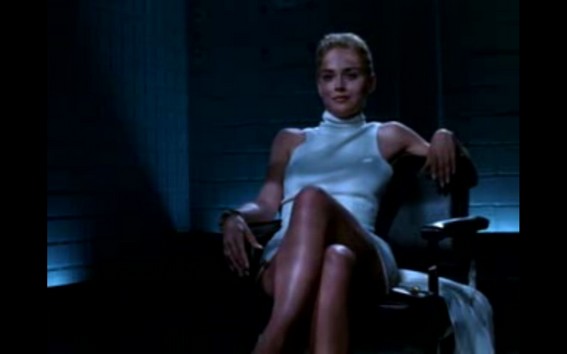 |
– Quake (id Software, 1996)
This episode was of course influenced by a whole genre of video games, “first-person shooters”, the most influentials of which in terms of general design and aesthetic were the original “Doom” in 1993 and “Quake” in 1996, both on MS DOS (at first) and both by id Software. “Quake” specifically featured an excellent dark ambient score by Trent Reznor (Nine Inch Nails) that would also fit perfectly in an X-Files episode.
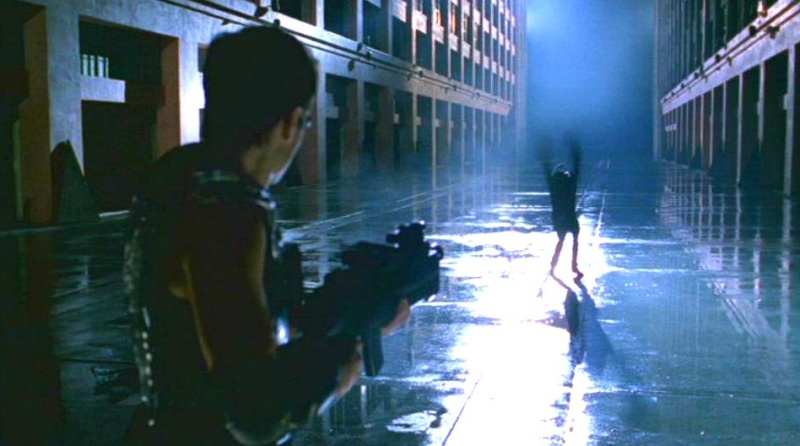 |
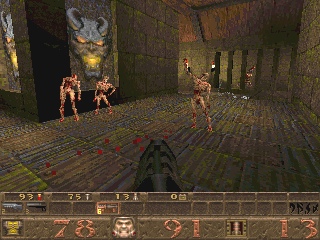 |
– The Matrix (The Wachowski Brothers, 1999)
The cyberpunk and sunglasses of the game costumes in this episode might be, in part, due to, again, “The Matrix” and its massively cool costume design.
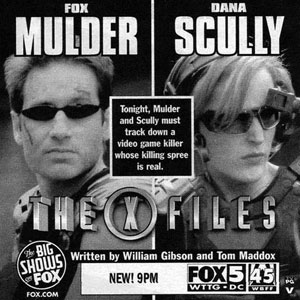 |
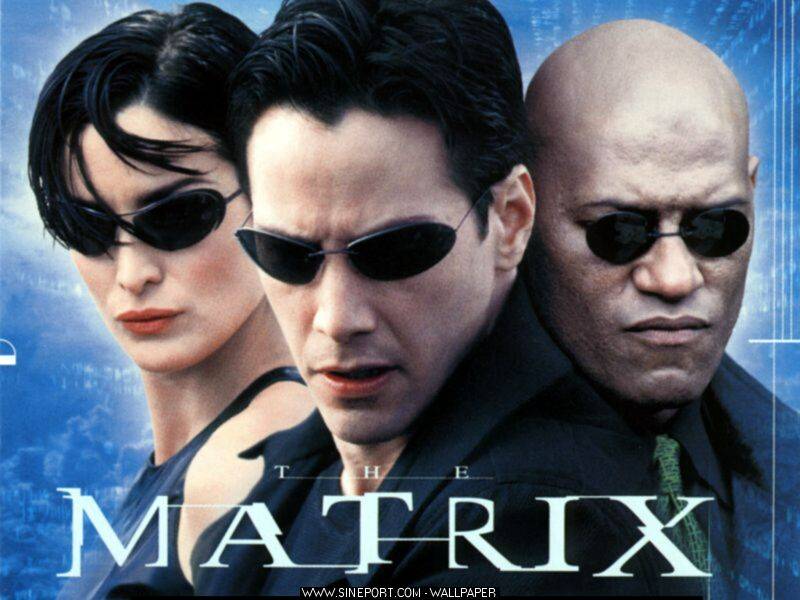 |
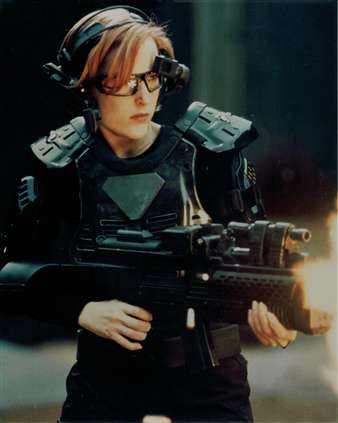 |
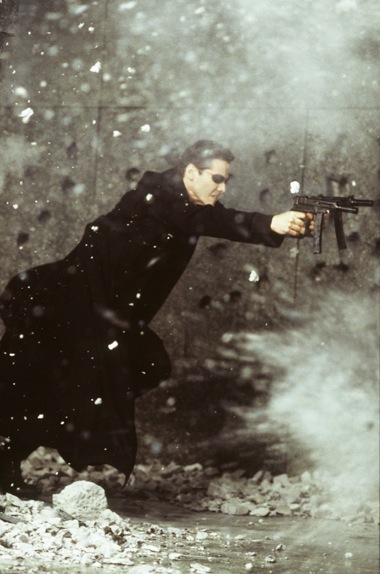 |
7X16: Chimera
– Psycho (Alfred Hitchcock, 1960)
The closing shots of the episode show housewife Ellen Adderly (Michelle Joyner) closed in a psychiatric hospital cell; throughout most of the episode, we thought that she was sane and the victim, but it turned out she was deranged and the perpetrator. The story and shots are similar to the ending of Hitchcock’s legendary film, with motel owner Norman Bates (Anthony Perkins), revealed as a split personality and a murderer, closed in a psychiatric hospital cell.
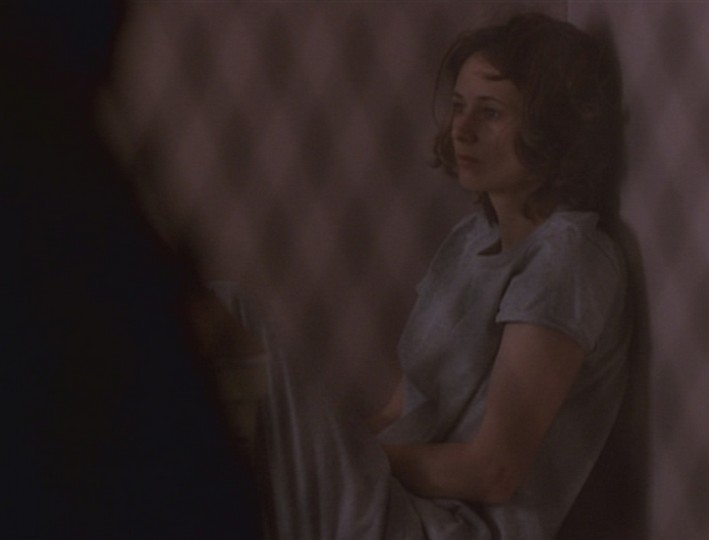 |
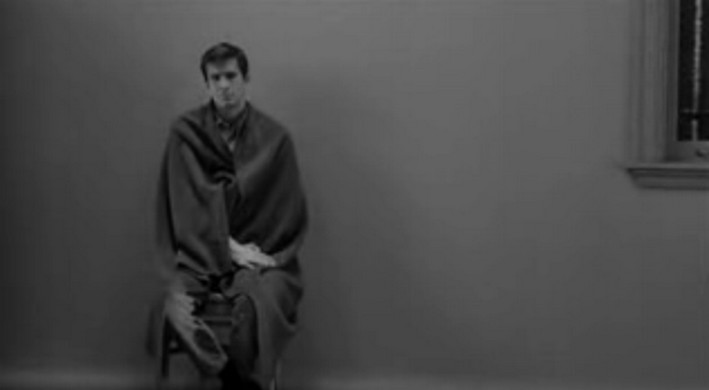 |
– The Birds (Alfred Hitchcock, 1963)
In an episode with already a Hitchcock reference, it’s difficult not to draw parallels between the crows in the episode and Hitchock’s other legendary film, where menacing crows also appear. Incidentally, “The Birds” was one of Veronica Cartwright’s first roles, some 35 years before she would take the role of Cassandra Spender on the X-Files (5X13: Patient X).
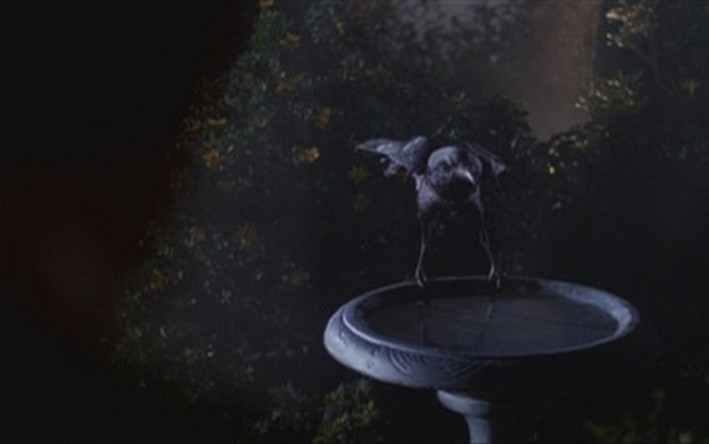 |
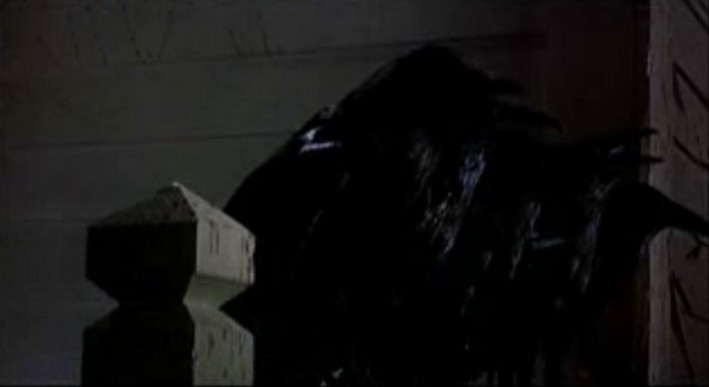 |
– The Crow (Alex Proyas, 1994)
Another film with crows also comes to mind. Apart from the bird itself that follows or announces the killer, the similarities also lie in the supernatural nature of the killer: a spirit with a zombie appearance in the case of the episode, a man with stigmata risen from the dead in the case of the film, both being motivated by revenge.
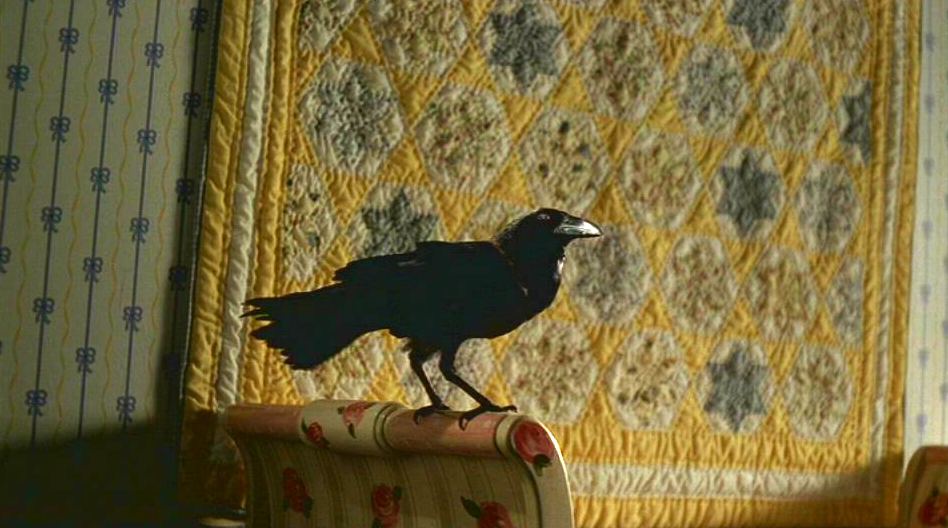 |
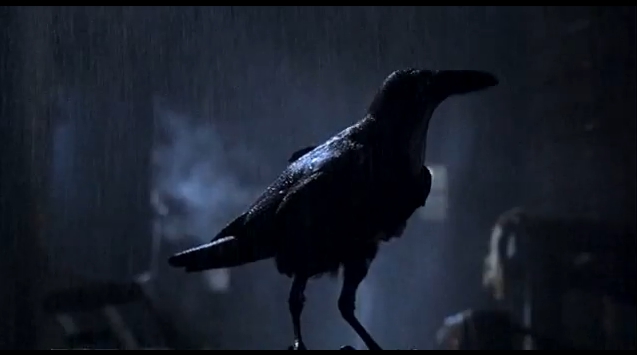 |
7X18: Hollywood A.D.
– Jason and the Argonauts (Don Chaffey, 1963)
The dancing skull and bones in this episode look like they are made in stop-motion, giving the scene an odd, comical feeling. Stop-motion skeletons were most memorably portrayed in “Jason and the Argonauts”, where Jason and his crew fight a host of skeletons. The stop-motion special effects were helmed by Ray Harryhausen (see also 3X20: Jose Chung’s ‘From Outer Space’).
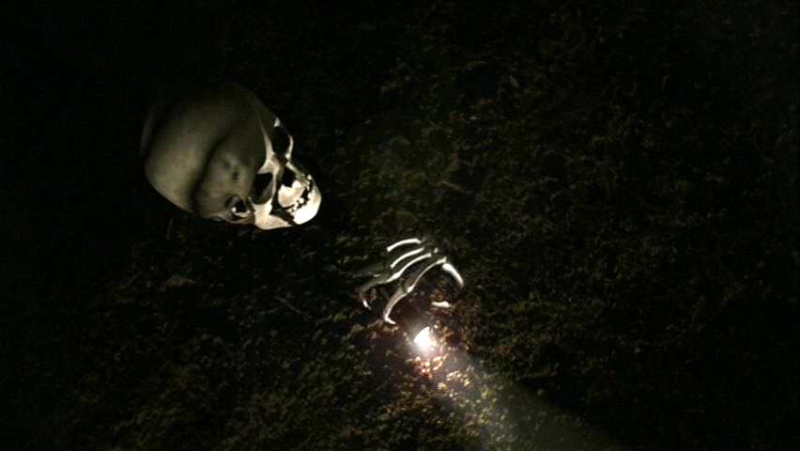 |
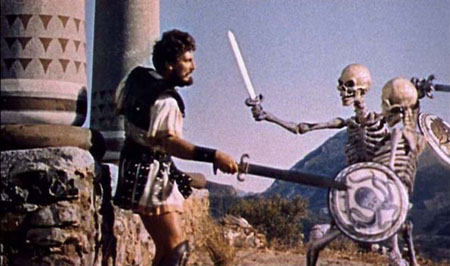 |
– Evil Dead 3: Army of Darkness (Sam Raimi, 1992)
Another memorable instance of stop-motion skeletons was in the second sequel in the well-known “Evil Dead” series, which is a mix of parody and horror.
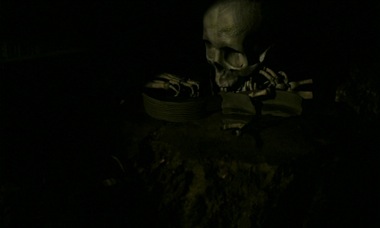 |
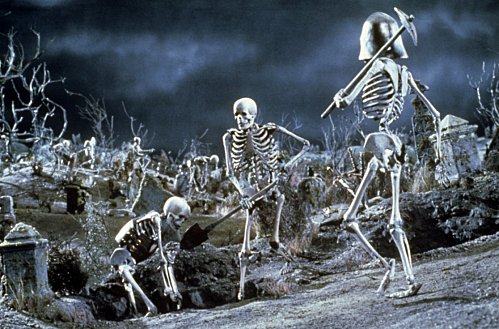 |
7X19: Brand X
– The Insider (Michael Mann, 1999)
Difficult to talk of cigarettes and the cigarette industry in the late 1990s and not to think about the story of Jeffrey Wigand, a whistleblower in the research branch of a tobacco industry that in 1995 came out with accusations of them manipulating the nicotine content of their cigarettes, and the law suits that followed. The sleak Michael Mann film starring Russel Crowe is based on this story, it came out in November 1999, barely a few months before the episode aired.
7X21: Je Souhaite
– I Dream of Jeannie (Sidney Sheldon, 1965-1970)
At one point Mulder crosses his arms and nods his head. He imitates a genie/jinn of course, but this is also a reference to the popular sitcom “I Dream of Jeannie”, where the genie Jeannie and her “owner” fall in love: Mulder imitates Jeannie’s mannerisms when she makes her magic come true. The theme song to the series is also hummed in the episode, and Mulder says “except Barbara Eden never killed anybody”: Barbara Eden is the name of the actor who portrayed Jeannie.
 |
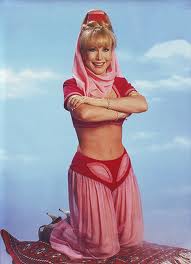 |
– Memoirs of an Invisible Man (John Carpenter, 1992)
This film is a mixture of science fiction drama and comedy and narrates the adventures of a white-collar analyst who becomes invisible because of an accident in a scientific laboratory. The invisible man (Chevy Chase) wanders around, goofs around, tries to manage a new relationship with a woman (Daryl Hannah) and is chased by the CIA. Some of the humorous scenes are similar to the invisible man scenes in the episode wandering around the street.
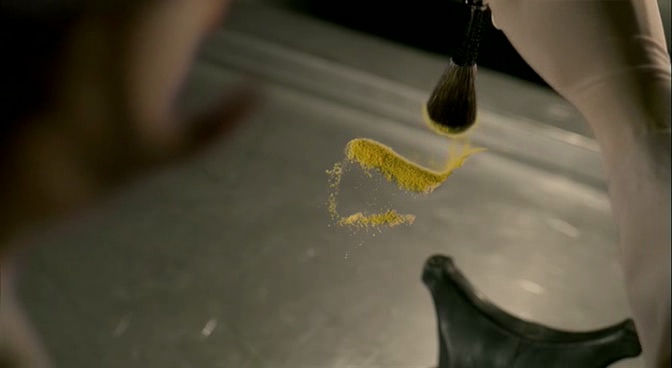 |
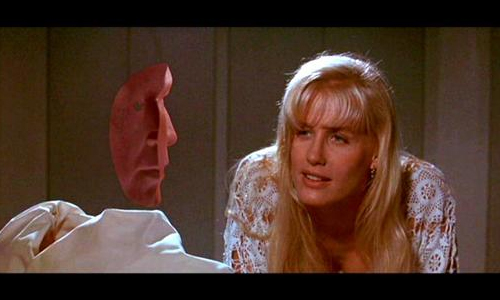 |
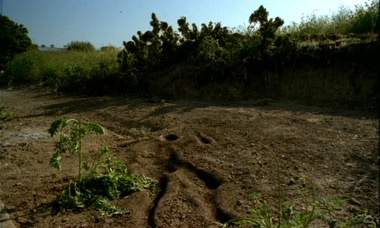 |
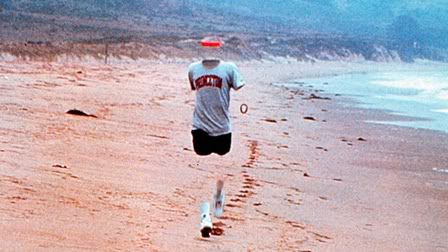 |
7X22: Requiem
– The Last Supper (Leonardo Da Vinci, 1498)
In perhaps the only direct influence from paintings on the X-Files and certainly the oldest in this list, is the very voluntary setting up of Mulder’s last meeting with nearly all the recurring cast of the series (those left alive at this point) before his abduction by aliens, a departure that can be interpreted as an ascension to a higher sphere. The panoramic point of view of the shot and the arrangement of all figures in a straight line behind the table positioned around the central character were made to echo Da Vinci’s painting. The painting is of one of Christianity’s best known moments, Jesus’s last supper with his disciples before he was betrayed by Judas, also present on the painting, and his imprisonment and eventual crucifixion; this is also the first Eucharist, with Jesus distributing bread representing his body and wine representing his blood. In the X-Files, Mulder is of course the Jesus figure; Krycek could be the Judas figure, since it is hinted that he lets Mulder be abducted later on; there was no female figure on the painting, although some have speculated that Mary Magdalene is there (The Templar Revelation, Lynn Picknett and Clive Prince, 1997; The Da Vinci Code, Dan Brown, 2003), so Scully could be that figure.
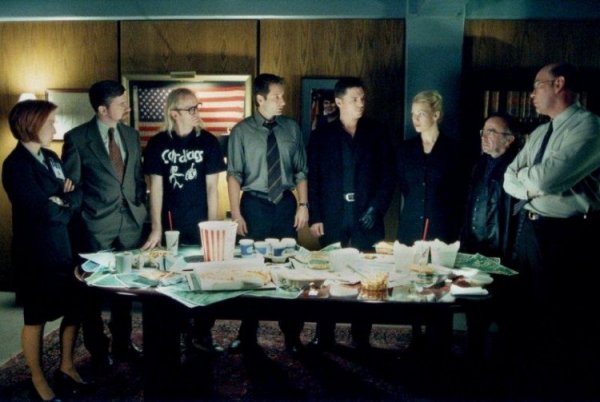 |
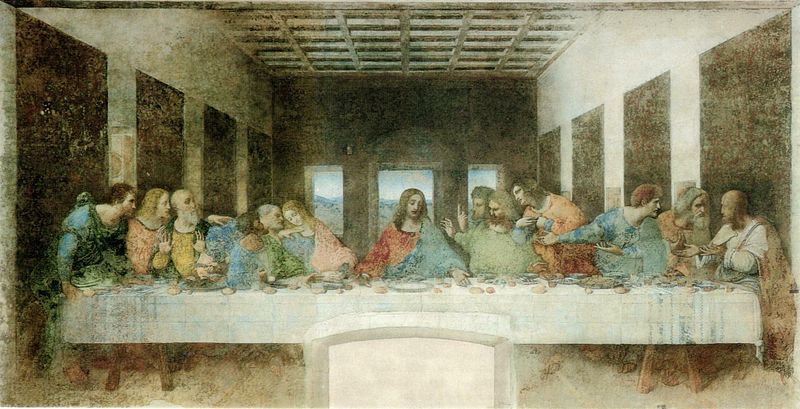 |
This painting has been used quite a bit in subsequent TV series, especially in marketing, since it does a good job at presenting all the characters: “The Sopranos” was there first (season 1 promo photo, 1999), “Oz” (a live-action portrayal, episode 4.4, August 2000), “Battlestar Galactica” (season 4 promo photo, 2008), “Lost” (season 6 promo photo, 2010), and many others…
– Cocoon (Ron Howard, 1985)
The shots with Mulder’s abduction, with a bright light source coming from above, are similar to the final scenes in “Cocoon”, where the rejuvenated elderly people are taken away by aliens.
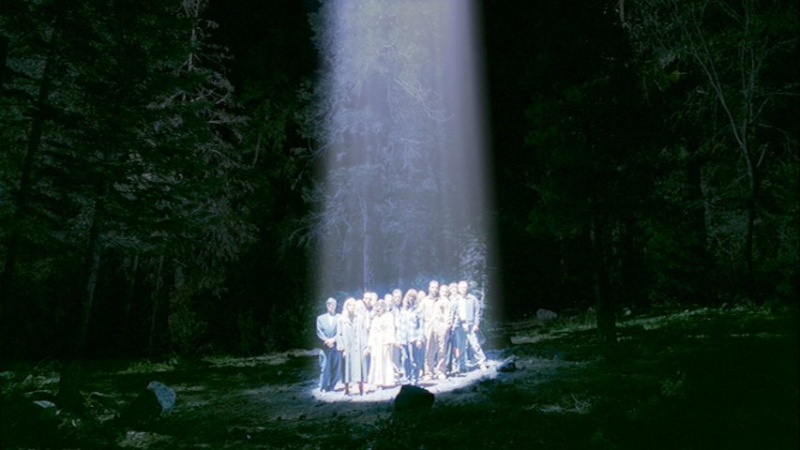 |
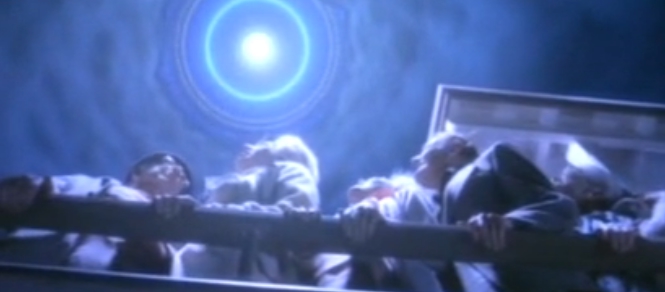 |
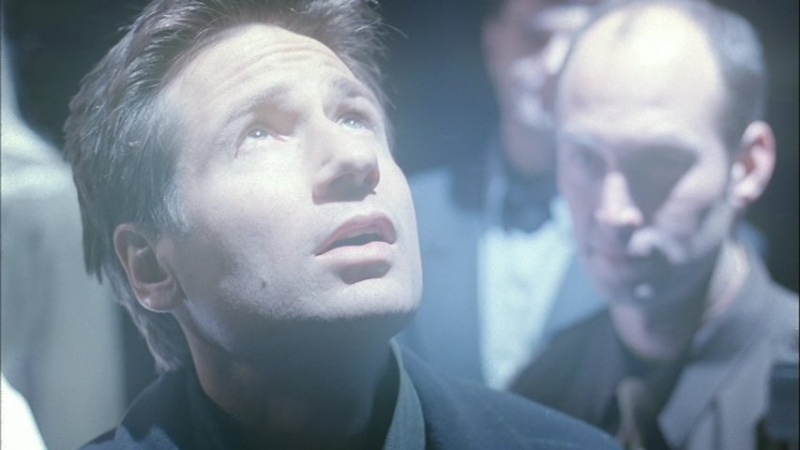 |
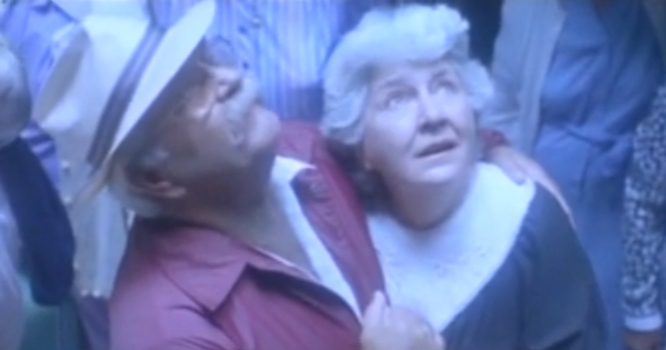 |
The Episode of the seventh season “Sein und Zeit” is named after a book by the german philosopher Martin Heidegger. This book is about Fear and this book is one reason why english speaking people use the word “Angst” today. Angst means fear in german.
Heidegger was Influenced by Fyodor Dostojevski, whose “The Grand Inquisitor” was an influence on an earlier X Files episode.
There are also a few parallels between the book and the episode.
According to Heidegger, many people lie to themselves and pursue stupid illusions and live unfree lifes. But when confronted by fear and the highest possible amount of fear would be the death of a loved one, people are given the chance to see through the illusions and rethink their purpose of life.
Something quite similar happens to Mulder in this episode.
You are entirely right, the Heidegger reference is obvious, thank you.
This is an omission on my part, as in the beginning I was only adding visual references, then expanded to fiction literature, and only in some cases non-fiction. I will definitely add Heidegger, also Nietzsche in “Amor Fati”.
On topic of the Sixt Extinction: The opening (I don’t know. Either of part 1 or part 2) with the time lapse photography, strongly reminded me on the movie Koyaanisqatsi.